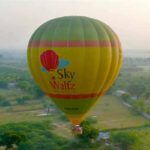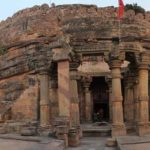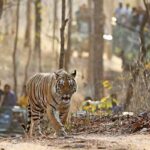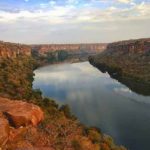Panna National Park is a popular wildlife tourism destination, close to Khajuraho temples site. As a wildlife safari destination, it is prominently highlighted in Central India tourism map. A range of flat – topped hills rise above the east bank of the ken river, 40 kilometers south-east from Khajuraho on the Bamitha to Panna road. This area is protected as the Panna National Park and boasts of the last vestiges of the glorious teak forest that once covered so much of the region.
The teak forests are magnificent just after the monsoons, an in autumn when great pyramids of teak flower perfume the atmosphere. In summer the giant teak leaves wither into lacy skeltons and fall, covering the earth with a carpet of many hues. The park is open from October to June during which we can enjoy jungle safaris in this tiger reserve. During monsoon season, park remains closed for tourists. Panna National Park The park is psread over 543 square kilometers with picturesque gorges, waterfalls and thick teak forests.
Only petrol-driven jeeps are permitted within its confines, and an early morning guided tour, if lucky, you may see the graceful Tigers, Leopards, Sloth bear, Spotted deer or Chital, the Indian gazelle, a herd of wild boar, Hyena etc. It is also good for birding. Its rocky hilly offers ideal place for vultures nesting due to which here we can see 6 different species of vultures which is special attraction of Panna jungle safaris. Forest area is adjacent to Panna National Park town which is a historic place.
The city’s royal past dates back to mid of 17th Century AD, when it became the capital of Maharaja Chhatrasal’s kingdom. On the other hand, with Ken River passing through Panna hills, the city has a wildlife-friendly present. You can find the majestic tiger, the ghariyal – a huge reptile found only in the Indian subcontinent, and a variety of flora and fauna in Panna National Park. It was declared in 1994 as the 22 Tiger reserve of India and fifth in Madhya Pradesh.
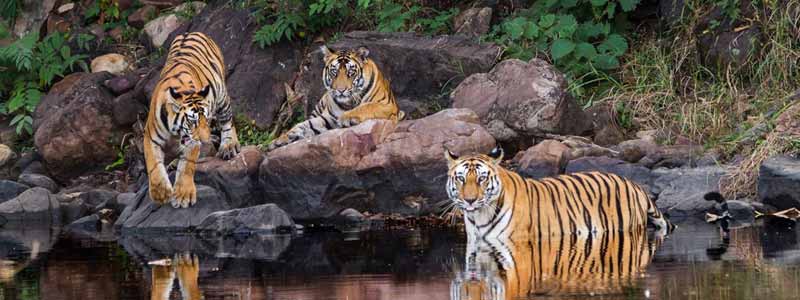
History of Panna National Park
Panna National Reserve was established in the year 1981 by the Government of India. This 22nd tiger reserve of India that was recognized under the project tiger was also declared as a Project Tiger Reserve in the year 1994. The area of Panna National Park also included some of the major parts of the former Gangau Wildlife Sanctuary which was created in the year 1975. The reserved forests of the Reserve in Panna district and some protected forests on Chhatarpur district were the hunting preserves of the erstwhile rulers of Panna, Chhatarpur and Bijawar princely states.
Today the area of Ganagu Sanctuary is the part of the territorial forests of the present North Panna Forest division to which a portion of the Chattrapur Forest division was also added later. It was in the year 2008 that the real story starts when the reserve area of Panna lost all its tigers to poaching leaving only 2-4 tigers left. Gradually, it caused the loss of the morale of the staff of Panna jungle authority and so in the following year, i.e. in 2009 Mr. R. Shreenivasa Murthy, IFS as field director of Panna Tiger Reserve initiated the task of reintroducing tigers into the park.
In collaboration with WWF and PATA, Murthy introduced two tigers to Panna, one from Bandhavgarh and the other from Panna Tiger Reserve with intricate scientific inputs. Under this project Mr. Murthy and his team translocated one male from Pench and a tigress from Kanha with proper monitoring and protection, where they achieved successful breeding to bring four litters to them. Since then, the officials are focusing on the reproduction of more and more cubs in the area to maintain the previous counts of the tigers in Panna National Park.
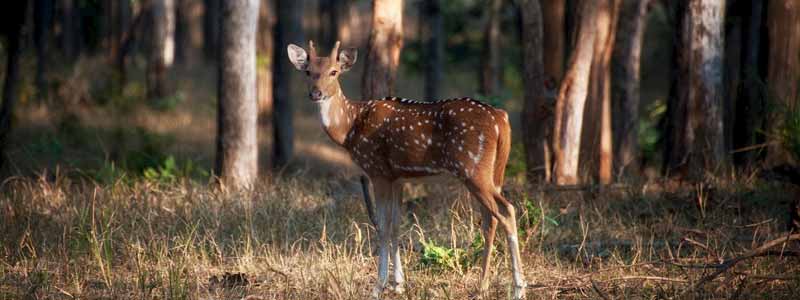
Highlights – Panna National Park
- Panna Tiger Reserve is situated at just 25 kilometer from Khajuraho – merely half an hour drive
- Spotting Tiger inside the national park fully depends on the luck but regular sightings are reported
- Entry Gates – Madla and Hinauta
- Cheetal, Sambar, Nilgai, Chinkara, Chowsingha, Langoor, Wild boar and Jackal are frequently sighted
- Other important attractions include Gorges and falls along the course of the Ken River
- The dynamic dry deciduous forest changes color from lush green in monsoon to desolate dry grey in summer
- Apart from wildlife lovers, Panna National Park receives visitors who exclusively visit the famous Pandav Fall
- Approx eight species of vultures and crocodiles are found in Ken River
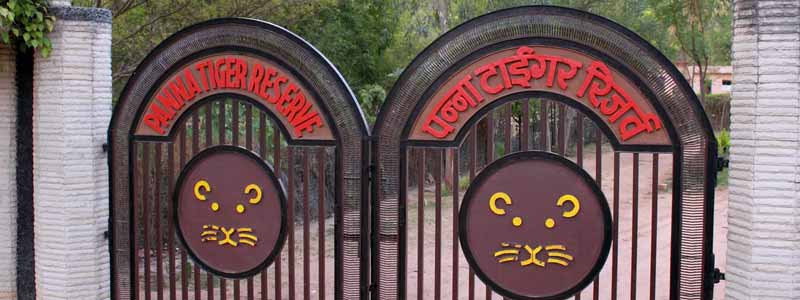
Flora and Fauna in Panna National Park
Many species of wild animals are found in and around the park. Panna National Park is known for the tiger along with Sambhar, Panther, Blue bull, Antelope, Bear, Chinkara, Spotted deer, wild dog, Wolf, Jackal and Monkey.
The park also has various reptiles like snakes, lizards and few amphibians as Crocodiles, frogs and Gharials. Panna is a home of about 200 bird species.
The birds spotted here are white-necked stork, Honey Buzzard, the Bar-headed Goose, the Blossom-headed Parakeet, the King Vulture, Paradise flycatcher and Scimitar babbler etc. Also checkout Birding tour India.
Due to the dry and hot climate with the presence of low Vindhyan mountain soils, Panna has dry forest. Apart from big grasses and sharp woodlands Panna is a home of different trees as Salai, Saja, Achar, Tendu, Seja, Kullu, Mahua, Aonla and Bel.
Few distinctive floral plants in the park are Melanoxylon, Diospyros, Tectona grandis, Madhuca indica, Buchnania latifolia, Anogeissus pendula, Lannea coromandelica, Bosswelia serrata and Anogeissus latifolia.
Best Time to Visit
The Panna National Park has tropical climate. It is located on Vindhya mountain ranges in which Bandhavgarh national park lies. It is open for visitors from October to June months. Here we can experience all 3 seasons i.e. monsoon, summers and winters. Here tourism remains similar in all the seasons. Visiting Panna in October to December month offers good birding, waterfalls photography and scenic nature. Those who are interested in overall wildlife may consider October to December as best time to visit.
Those who are interested in tigers photography, prefers to visit in summers i.e. from March to May. This is the best time to visit for tiger photography. Due to rocky outcrops, summers are too hot in daytime, though this is the time when one has the maximum chances of encountering the exclusive wildlife of this park. Winters are cold and comfortable and the temperature generally remains under 25°C. Monsoon touches this region in July and continues till mid-September.
How to Reach
Panna national park is located in Panna district of Madhya Pradesh state. It lies in Northern region of Madhya Pradesh in Vindhyan ranges. It is a popular tiger reserve of Central India and easily accessible by road, train and flight options. Here we have discussed information on how to reach Panna National Park by various modes of transportation. Let us check the details given below:
By Air: Nearest airport for Panna national park is Khajuraho Airport, at a distance of 40kms. It is a medium size airport, having connectivity with Delhi, Varanasi. Second best option is Jabalpur Airport having flight connectivity with Delhi, Mumbai, Hyderabad.
By Train: For visiting Panna national park, nearest railway station (40kms) is in Khajuraho, having limited connectivity from Varanasi, Delhi, Agra, Bhopal. Second best option is Satna railway station (80km) having good train connectivity from major cities and tourist destinations like New Delhi, Agra, Mathura, Varanasi, Allahabad, Katni, Jabalpur, Bhopal etc.
By Road: The nearest bus stand is Panna connected to Khajuraho and many other places in Madhya Pradesh by a good road network. Mandla, at a distance of around 24 km southwest of Khajuraho, is a good transport centre. One can get buses and other road transport modes from here to the Panna National Park.




